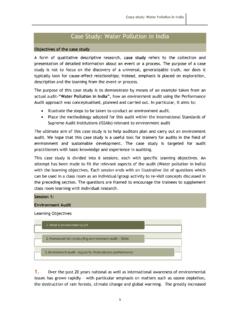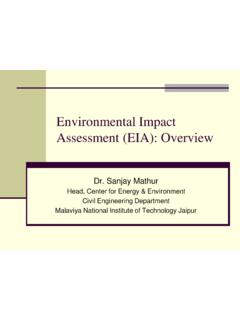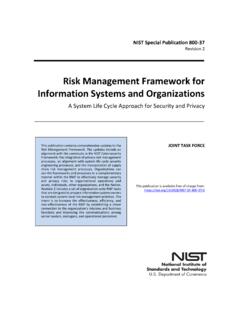Transcription of SUSTAINABLE WASTE MANAGEMENT : CASE STUDY
1 SUSTAINABLE WASTE MANAGEMENT : CASE STUDY JayantJoshi WASTE ClassificationMunicipal Solid WASTE Industrial WasteMedical WasteDomestic WasteBio-DegradableKitchen WasteVegetables, Peels, Garden WASTE (Tree Leaves)Non-Bio-DegradableRecyclablePlast ic,Glass, Metal Paper, Non-RecyclableThermacoal,Sanitary Napkins,DiapersVegetable Market WasteConstruction WasteComposition of MSW ~51% of Domestic WASTE is IndiaNorthIndiaSouth IndiaWest IndiaComposition of MSWR egion/CityComposition of MSW in India & Regional VariationCompostable (%)Recyclables (%)Inerts (%)MSWM ComparisonDomestic WASTE GenerationMixing in HouseUnsegregated WASTE CollectionCollected by Municipal Corporation (Trucks)TransportationOpen Dumping AND/OR BurningSegregation at SourceSanitary LandfillOr Incineration RecyclableRecycling PlantNon-Bio-DegradableExisting MSWM SystemProposed MSWM SystemBio-DegradableComposting At SourceVermin-CompostAerobicCompost AnaerobicBiogasIndia: Overview ~920m tons of MSW landfill or 843m tons Open Dump (91% of Total WASTE Generated) Inefficient handling of WASTE by municipalities (50-60%) Receive Treatment : 10% of the collected WASTE Scientific Disposal in Landfill: ~ 0% No segregation, unsafe disposal Discarded Composting Rejects : 60% Utilized Mixed WASTE : Only 6-7% Non-organics and heavy metals reduced efficiency Calorific Value of MSW-India: NOT suitable for Energy Generation Although LFG recovery reduces overall GHG emissions Opportunity to produce tons of WASTE compost Produces m TPY of RDF in the form of composting rejects Insufficient information on performance of MSW composting facilities Average Expenditure on SWM.
2 15 -20% of Total Budget 75% Salaries , 20% Transportation, Rest on other O&M Prohibition Against Littering the Streets, Deposition of Solid WASTE onthe Streets, Open Defecation, person shall litter public streets or public places or deposit or cause or permit to be deposited or thrown upon or along any public street, public place, land belonging to the local body, State or Central Government or any unoccupied land or on the bank of a water-body any solid WASTE except in the receptaclesspecified in 2, 6 and 8 above or resort to open : Existing Scenario Population : ~ Budget for WASTE Disposal: 2300 Crore/yr WASTE Generate: 11,000 TPD (2014-15 BMC Report) ~630 gm/per Family /Day 15-20% WASTE remains uncollected Almost 0% Gets Scientific Treatment >80% of Domestic WASTE is Bio-degradable WASTE is dumped on Deonar ,it s capacity is ended 25 years back,HariomnagarMulund it s closer is declared ,the third is at Kanjurit is not yet stared fully because of litigations.
3 The height of the WASTE tower at Deonar has reached about 55 meters or 165 feet equivalent , as against the 35-metre cap mandated by the Airports Authority of Dombivali Corporation scenario No scientific dumping ground allocated Last two years all the new Housing projects are being rejected Unauthorized construction are in full swing 200 crore revenue loss Day by day MSW quantity is on increase Dirtiest city in India 24 Hrs garbage heaps are left burning Thane and Mumbai are also on the same Path SIT inquiry for And 4408 Cr Rs irregularities .Carelessness of the citizensUnscientific way of handling the wasteAll the Rivers are polluted Our all the water resources are polluted and not giving potable water Mumbai Maladbeach is full of garbage thrown in the deep sea ,came back with high tide Holy water to immerse Flower Hazards of open dumping Open Burning of Solid Wastes and Landfill Fires Emit 22,000 TPY of pollutants CO, HC,H2S , NOx, SOx, SO2 , dioxins, furans Particulate Matter Burning at Ground Levels Upper Respiratory tract Disorders to the Locals Mix WASTE Compost Samples Fall Below QC standards Exceeded Quantities of Heavy Metals Soil, Air, Water Pollution Physically Challenged Next Generation Agenda Understating Municipal WASTE Existing Methods of composting Merits and Demerits Case Studies Proposed Solution De-Centralization of WASTE Summary Conclusion Next StepsDeonarFire Deonar.
4 Largest Garbage Dump in Mumbai, (possibly India) 132-Hectare Site Receives ~4000 to 5000 Tons of WASTE /Day Home to Thousands of Scavengers Open Pit Toilet Leading to Health Hazards Rs. 3,700-Crore contract for partial closure of dump and building an integrated WASTE MANAGEMENT facility given to United Phosphorous (2009) Disputes ->No Compost Plant Yet Caught Severe Fire on Jan 28. 2016 Severity: Visible even from Space Thick Smoke (Acrid smoke)That Bloated Out the Sun Severe Threat to the health of those who live nearby Fire lasted for more than four days Possible Causes: Self combustion of methane inside the dump Misconduct ? Irresponsibility ? of Trash in Deonar~30m Tall 9 Story !! -NASANASAS wacchsBharat AbhiyanCurrent Mentality People s Attitude Innocence Ignorance ArroganceEducation on paper The civic administration, in its 2014-15 budget, has allocated around Rs 44 crore to increase awareness among citizens regarding WASTE MANAGEMENT , to improve civic sense and also streamline the role played by NGOs in this process.
5 Decentralization :Experts opinion The BMC needs to draw up a policy to micro-manage organic WASTE , said , professor, centre for science and engineering, Indian Institute of Technology-Bombay. Estimates suggest that the Garbage treatment is Rs 60,000-crore industry has the potential to grow at 10-15 per cent a yearComparisonMethodsMeritsDemeritsRecyc le Integral part of SWM Robust Collection and supply chainin large cities Informal Sectored, Successful only if segregation at source follow ed Only ~20% to 35% Available in India Aerobic Composting Suitable for Organic WASTE (51%-India) Significant Reductionin Transportation Cost Fast and Cheap Low Space ,No Odor ,Most Eco-Friendly Proved to be the best if decentralized 100 Nitrogen is recovered Possibility of heavy metals entering into food chain if used as Mixed . If it is done on centralized way it is costly affair Small Scale Bio-Gas/Methanization High position on hierarchy of SWM Divertwaste from landfills Only successful at small scale Low Efficiency Excessive WaterRequired MediumSpace Required Slushy Slurry as bi-productVermiCompost Gets good quality manure Not advisable for Kitchen WASTE Slow process failure chances are more Refuse Derived Fuel(RDF) Potential Substitutefor Coal Divert WASTE from landfills 5plants Manyfailures from case studies Severe problems during operation Lack of funding, logistics and WASTE to Energy Combustion(WTE) Potential Substitutefor Coal Recommended after all possible recycling and composting Low Efficiency due to lower Cal.
6 Value GHG Emissions Inert Organic Bi-products Flyashis anotherwaste generated Segregation at Manchester Segregation in UK At Food Joint Key Concepts: WASTE Reduction National Level Law must be implemented very strictly promotion of consumer awareness. promotion of producer responsibility for post-consumer wastes. Required Change In Packing Material Local Level At Source Segregation . recovery of materials from mixed WASTE . Implementation of Three R support of home composting, either centralized or LevelsL1 Individual Inside Our HouseL2 Small-Sized Groups 10-15 families prepare their own composting pitL3 Mid-Sized Groups A society of 100 members WASTE MANAGEMENT . So that it will require mechanized mixing , sifting Discards:Contribution to Greenhouse Gasses GHGE missionDecompositionDomestic WasteOrganic DiscardsNatural Aerobic DecompositionCO2 EmissionNo Methane Not Considered in GHG ComputationsAnaerobic EnvironmentHigh CarbohydratesCH4 Emission 21 times more dangerous than CO2 High in Nitrogen (Food Scrap, Manure, Glass)N2O 300 Times more dangerous than CO2 Fish Bone diagram People are not cultured People are to be educated Corporaters are inefficient Dry and wet Garbage is not segregated at source There is no enough space for compostingMetropolitan cities are growing uncontrolled There is no punishment for misbehavior No enough funds Dumping ground is the only solution of this problemCity garbage problem is going out of control SUSTAINABLE solution Composting basket L1.
7 Kitchen Kompost Compost Basket It converts all the kitchen WASTE in to good compost inside the kitchen without any smell Gives good quality compost useful for organic Garden Very Economical, Last for many years No recurring cost Makes the citizen aware of their duties Converts Food WASTE ,Fruit WASTE , FlowersTea powder, Fish bones ,Prawn , Egg shellsin to compostVery fast and RobustL1 Scaled to L2 Common box made up of mesh with Netlon inside of 2X3X2 size of 325 Lts capacity Easily assembled, Good mobility Highly recommended for 15-20 families , hotels , Canteens and Garden WASTE Can be kept open no civil structure is required Low Capital cost or running cost No emission of Methane . Useful for about 25 kg WASTE /dayL2 Example: Up Grade-Bangalore Self Sustaining Zero WASTE Community In-house Bulk Composting Solution Up GradeMix + Food WASTE = Compost (25-30 Days) Primary Segregation into Dry and Wet by Residents ~78kg of wet WASTE /day/complex 780Kg/month Beneficial Microbes Isolated from Tropical Agricultural Soils Blended with Coco peat as Carrier Material Enhance Aerobic Decomposition Low Cost Shredder (Rs.)
8 30,000) + Crates ( ) by Society Worm Free and Odor FreeCase Studies White Coal (RDF/WTE) Gorai Dumping Ground Closure First Housing Society: No WASTE to LandfillsWhite Coal Converting Fallen Trees Into White Coal ( Briquettes ) Cheaper than firewood and black coal Replaces traditional coal, lignite, gas etc. Application: Boiler Fuel in Maharashtra, Gujarat, Tamil Nadu and Rajasthan India : Leading Manufacturer and Consumer -Wikipedia Not the Ideal Way Wastage of Biomass (Organic Material) Required Infrastructure consumes more energy than the Need to convert into compost for efficient utilization Emits Co2 ,which is trapped by Plants Zero garbage Society in Parel:No WASTE to Landfills Marathon Era Co HSC-Parel, Mumbai 36 StoreyComplex 236 flats Generate 300kg/day No Impact on Environment 1500sqft WASTE Sorting Area Section 1: Bio-degradable or wet WASTE is Composted Wet WASTE , Kitchen Refuse Section 2: Recycle 9 Categories (Plastic, Glass, Paper, Electronics) Awareness in !
9 ! 600kg of Organic Fertilizer per month Manure is used in society garden Excess is distributed among residentsBio-Digester: Green Project by BMC(Bio-Methanization) Parel-Mumbai, Mumbai University Canteen Wet Garbage, Cow dung, non-potable Water Peels, Vegetables , WASTE / Extra food Biogas Cost 25000/Rs 5kg WASTE ,4 hours supply of gas 1m3 in 24 hours Residue is used as Organic manure in the Garden Remains slushy Requires a lot of water and space Low EfficiencyEffective But NOTIDEALM erits and Demerits L1 composting Your own Property Simple Maintenance The out put of this is valuable compost for your garden. This will eliminate the WASTE transportation from Kitchen to dumping ground Being aerobic process it is faster. Very Economical You have to pay from your own pocket It occupies space in your house If the user is not willing to follow the procedure the process fails . Its very difficult to change the mindset of person .NIMBY syndromeMerits Demerits Merits And Demerits of L2 composting Less Space Very Economical No Odor Significant Reduction in Transportation Cost Easy Maintenance Fast Conversion Aerobic Decomposition No GHG Require Cooperation of all No Control Over Team Members Everyone Need to be Aware Shared Responsibility System Fails if anyone Fails to segregate at source If not operated properly Anaerobic decomposition GHGM erits Demerits How do organic discards contribute to greenhouse gases?
10 By definition, all organic discards contain carbon. When theydecompose naturally under aerobic conditions the CO2 theygive off is part of the natural short-term carbon cycle6. Sincethis is part of the natural flux of CO2 it is not considered inGHG computations. However, when those organic discards areplaced in an anaerobic environment the decomposers willconvert and release the carbon as methane and other volatileorganic compounds which can contribute to global climatechange. Organic discards that are high in nitrogen, such asfood scraps, manures and grass clippings, under wet andoxygen-limited conditions, can also produce N2O duringdecomposition, roughly 300 times worse than carbon Closure Hectare : 2200 TPD since 1972 Total WASTE ~ million tons (26m high) Scientific Closure on July 25, 2009 by United Phosphorus Covering of Reformed Slopes with Soil Relocation and Reformation of Existing WASTE Landscaping and Compound Wall Construction Systems Installed Include Landfill Gas Collection and Venting system Leachate collection system Flaring System Incinerate the Landfill Gasses Flare Burner with 12m High Chimney Maintenance Period 15years Power Generation from Methane : for 10 !






